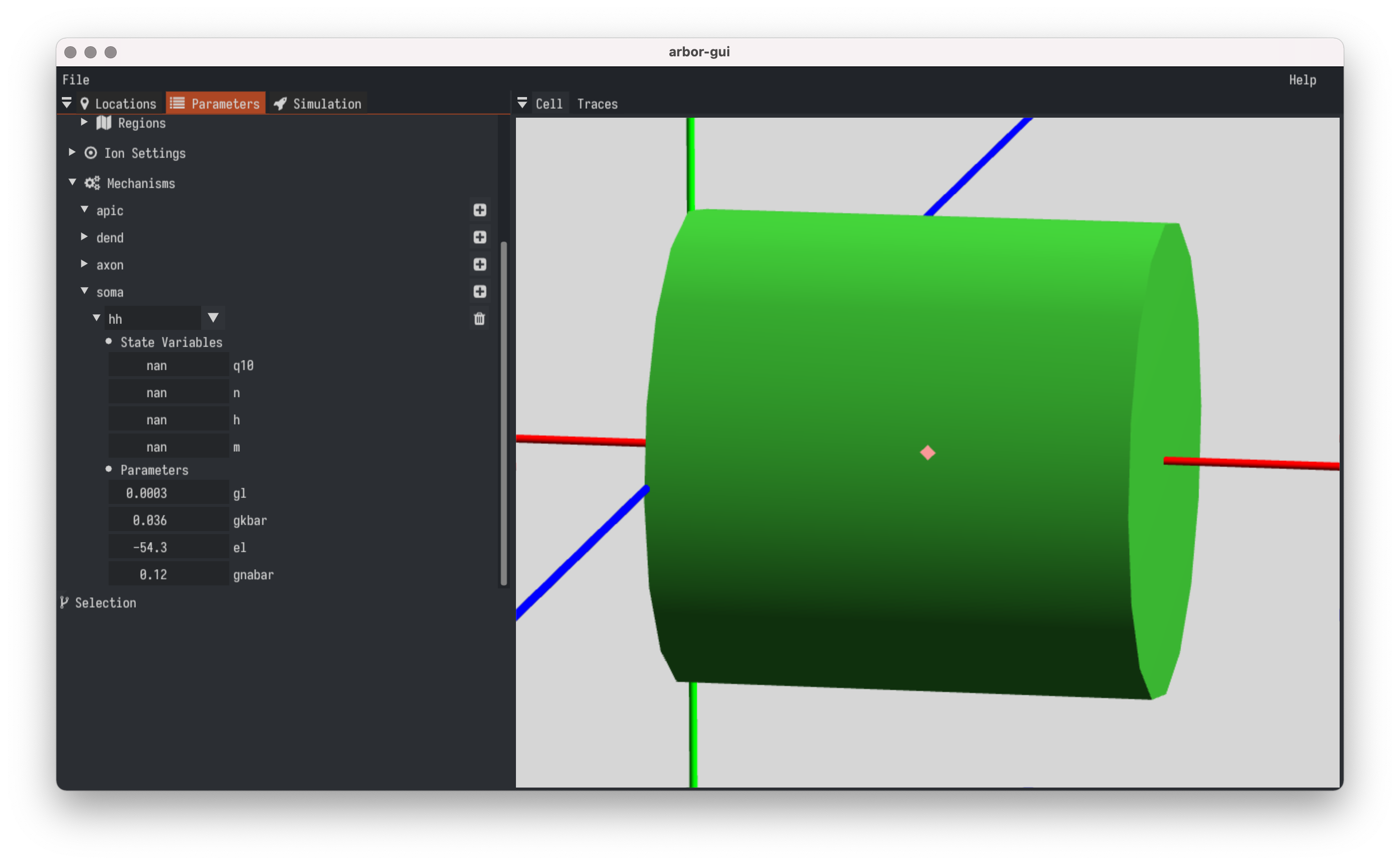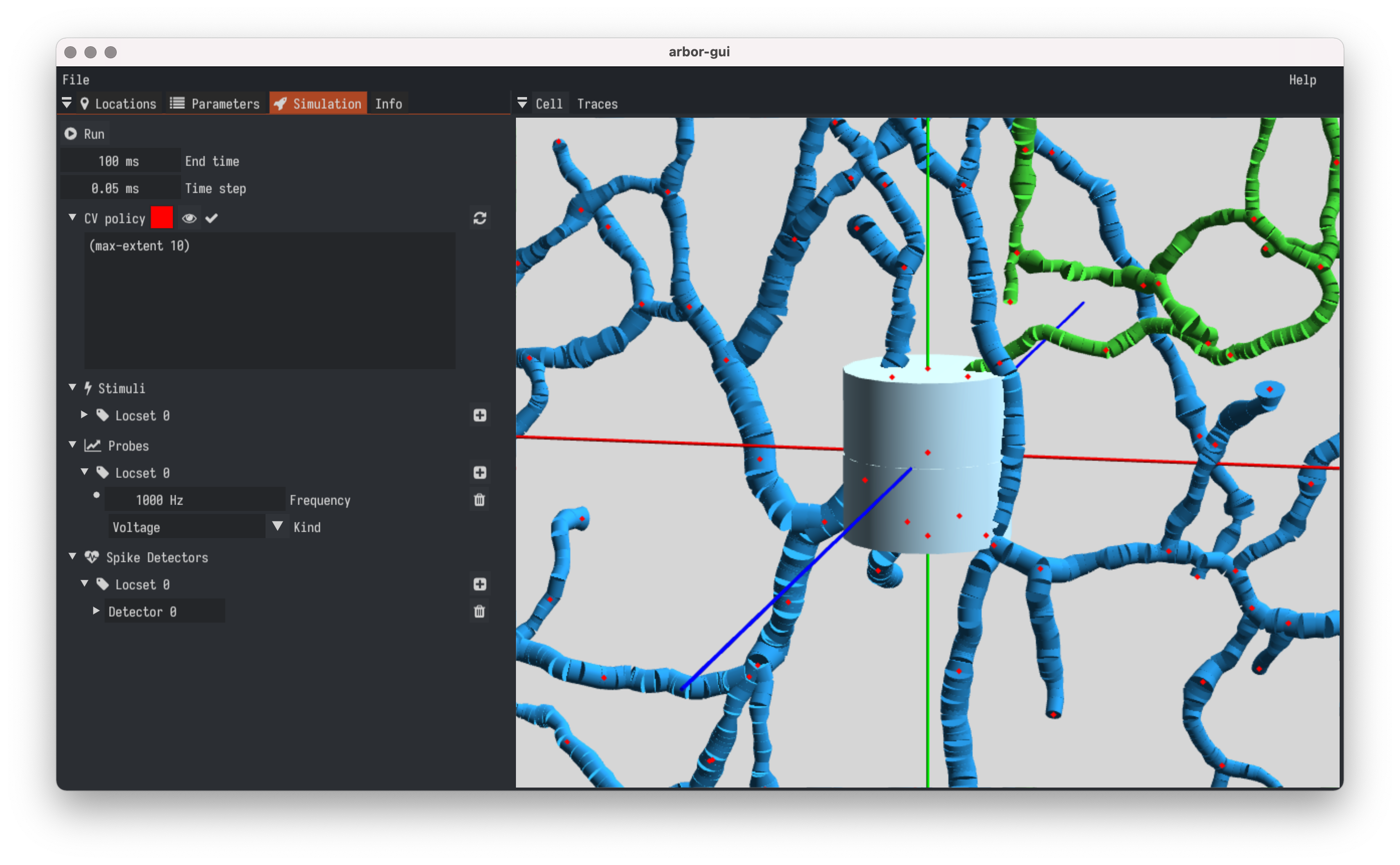Arbor GUI is a comprehensive tool for building single cell models using Arbor. It strives to be self-contained, fast, and easy to use.
- Design morphologically detailled cells for simulation in Arbor.
- Load morphologies from SWC
.swc, NeuroML.nml, NeuroLucida.asc. - Define and highlight Arbor regions and locsets.
- Paint ion dynamics and bio-physical properties onto morphologies.
- Place spike detectors and probes.
- Export cable cells to Arbor's internal format (ACC) for direct simulation.
- Import cable cells in ACC format
This project is under active development and welcomes early feedback. As of v0.8, releases of Arbor-GUI follow the version numbering of Arbor, e.g. Arbor-GUI v0.8 includes Arbor v0.8. Releases can be found here. Precompiled and self-contained versions for Macos and Linux are available at the same locations.
Note that the screenshots below are updated less frequently than the actual project. To get a feel for the workflow with Arbor-GUI, you can take a look at the tutorial.
We welcome bug reports and feature requests, please use the issue tracker here on GitHub for these purposes. Building network simulation is out of scope for this project (we might offer a different tool, though).
- Rendering of cable cell as seen by Arbor.
- Define locations in Arbor's Locset/Region DSL.
- Live feedback by Arbor's parser.
- Well-formed expressions are rendered immediately.
- Navigate with
- pan: arrow keys or hold [CTRL],
- zoom: +/- or mouse wheel,
- rotate: hold [SHIFT].
- Right-click to
- reset camera,
- snap-to a defined locset,
- set the background colour,
- tweak morphology orientation,
- toggle orientation guide,
- save the currently rendered image to disk.
- enter auto-rotation mode
- Hover a segment to show
- containing branch and regions,
- geometry information.
- Load mechanisms from built-in catalogues.
- Define ion species.
- Set parameters of mechanisms and ions.
- Set global and cell level defaults.
- Set per-region parameters like temperature, resisitivities, and more.
- Set global and cell level defaults.
- Timestep and simulation interval.
- Add Probes, Stimuli, and Spike Detectors.
- Set and visualise discretisation policy.
- Run a preview simulation and see probed traces.
- You can adjust the GUI layout by dragging and dropping windows and tabs.
- Dragging regions will change rendering order, so overlapping regions might be better visible.
- The Arbor GUI vendors its own copy of Arbor.
We have Apple Disk Images and Linux AppImages which are the preferred way of getting and using Arbor GUI. Simply download the version for your system and copy them to a directory of your choosing.
The Arbor GUI requires a functional OpenGL 3.3+ package and recent (as in C++20 supported) C++ compiler to be present on the system. Listed below are the standard instructions to install per platform. Mileage may vary, especially when installing OpenGL. You might need to update drivers, or have to execute other environment specific patches.
If you wish to build and perhaps modify Arbor GUI, start out by cloning the repository and creating a build directory:
git clone --recursive https://github.com/arbor-sim/gui.git
cd arbor-gui
mkdir build
cd buildNext, follow the platform specific instructions.
-
Install build dependencies
sudo apt update sudo apt install build-essential libssl-dev \ libxml2-dev libxrandr-dev libxinerama-dev \ libxcursor-dev libxi-dev libglu1-mesa-dev \ freeglut3-dev mesa-common-dev gcc-10 g++-10If your cmake version is less than 3.18, you will need to update it as well
cmake --version 3.16 # default on Ubunte 20.04 LTS # if pip is present pip install --update cmake
-
Add GCC10 as alternative to GCC and select it:
sudo update-alternatives --install /usr/bin/gcc gcc /usr/bin/gcc-10 10 sudo update-alternatives --install /usr/bin/g++ g++ /usr/bin/g++-10 10
Use
gcc --versionto confirm it is now version 10. If not you will need to runsudo update-alternatives --config gcc(and its analog forg++) and manually select the right number. -
Install Arbor GUI
cmake .. sudo make install -j 4
Users of Windows Subsystem for Linux will have to run an X-Server on their Windows machine and use X11-forwarding to display the GUI.
-
Install VcXsrv. Make sure you add the right firewall rules and a subnet mask for the incoming connections. An alternative is to disable access control when you start the XServer but this could have security implications for you. This is a great write-up of all the pitfalls you can encounter.
Key to the XServer forwarding are the extra settings during XServer startup:
-
Add the following to
.bashrc. Please note that it is similar but not identical to snippets you'll find elsewhere:export DISPLAY=$(awk '/nameserver / {print $2; exit}' /etc/resolv.conf 2\>/dev/null):0 export LIBGL_ALWAYS_INDIRECT=0
Please use a recent version of Clang, as installed by brew for example. The project has been confirmed to build and run with Clang 11 on BigSur and Catalina using this line
cmake .. -DCMAKE_CXX_COMPILER=/usr/local/opt/llvm/bin/clang++ \
-DCMAKE_C_COMPILER=/usr/local/opt/llvm/bin/clang \
-DCMAKE_BUILD_TYPE=releaseThis research has received funding from the European Unions Horizon 2020 Framework Programme for Research and Innovation under the Specific Grant Agreement No. 720270 (Human Brain Project SGA1), Specific Grant Agreement No. 785907 (Human Brain Project SGA2), and Specific Grant Agreement No. 945539 (Human Brain Project SGA3).
Arbor GUI is an eBrains project.
This project uses various open source projects, licensed under permissive open source licenses. See the respective projects for license and copyright details.
- Arbor: https://github.com/arbor-sim/arbor
- GLM for OpenGL maths: https://github.com/g-truc/glm
- GLFW for setting up windows: https://github.com/glfw/glfw
- Dear ImGUI library https://github.com/ocornut/imgui
- Iosevka font https://github.com/be5invis/Iosevka
- ForkAwesome icon set https://github.com/ForkAwesome/Fork-Awesome
- C++ icon bindings https://github.com/juliettef/IconFontCppHeaders
- fmt formatting https://github.com/fmtlib/fmt
- spdlog logger https://github.com/gabime/spdlog
- stb image loader https://github.com/nothings/stb
- Tracy profiler https://github.com/wolfpld/tracy.git
Test and example datasets include:
- A morphology model
dend-C060114A2_axon-C060114A5.asccopyright of the BBP, licensed under the CC BY-NC-SA 4.0 license.
The Arbor GUI entry on Zenodo can be cited, see CITATION.bib.





